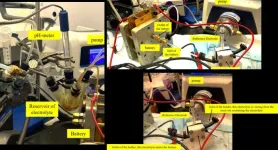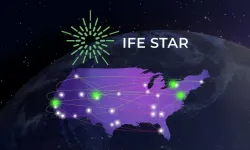(Press-News.org) NYU Tandon, collaborating institutions and industry partners have been awarded nearly $10 million to develop next generation communications technology.
The project, dubbed SALSA (Spectrally Agile Large-Scale Arrays), is funded by the U.S. Department of Commerce's National Telecommunications and Information Administration (NTIA) to advance U.S. leadership in open, secure communications infrastructure.
SALSA aims to create advanced wireless systems that operate in the "upper mid-band" spectrum — a region of frequencies relatively unused in cellular systems today that offers an optimal balance of coverage and data capacity. SALSA will develop an advanced radio frequency integrated circuit (RFIC) operating in these bands.
The RFIC will be designed for the Open Radio Access Network (O-RAN) framework to enable deployment in emerging commercial networks. The award comes through the NTIA's Public Wireless Supply Chain Innovation Fund, established under the CHIPS and Science Act to promote O-RAN development and domestic manufacturing of telecommunications equipment, seen as crucial for economic competitiveness and national security.
"SALSA focuses on the upper mid-band – a sweet spot in wireless communications," said Sundeep Rangan, the project's lead investigator. Rangan is the Associate Director of the NYU WIRELESS research center and a professor of electrical and computer engineering at NYU Tandon. "The upper mid-band frequencies provide an optimal balance of bandwidth and coverage, making them ideal for future high-data-rate applications. The spectrally agile features of the SALSA RFIC will enable coordination between cellular operators, satellites, and federal systems, ensuring robust communications even in adverse conditions. The scale of this investment – which we believe represents one of the largest federal commitments to O-RAN – underscores this work's importance."
"This project represents a pivotal moment in wireless technology development that builds on NYU Tandon’s leadership in advancing cellular networks," said Juan de Pablo, NYU’s Executive Vice President for Global Science and Technology and Executive Dean of NYU Tandon. "We're creating new technologies that will democratize advanced wireless networks making them more open, efficient and secure- helping ensure that the next generation of wireless innovation serves the broader public good while strengthening America's technological leadership."
The SALSA project is structured around four major tasks: developing specialized wireless chips, building modular radio platforms, integrating with open network standards, and analyzing system performance.
NYU Tandon will oversee a team of academic and industry partners to achieve those objectives. Pi-Radio – a startup spun out of NYU Tandon that received sponsorship from NYU WIRELESS, the Center for Advanced Technology in Telecommunications, and the NTIA – will lead development of the physical radio platform - including packaging, antennas, and system integration.
In 2023, NYU Tandon and Pi-Radio received one of the first grants awarded from the Public Wireless Supply Chain Innovation Fund. That award supported the development of an initial version of the system in the upper mid-band. The current project will build on this highly successful project to create an RFIC-based version with much lower cost and power and greater scale suitable for commercial systems.
Princeton University’s Professor Kaushik Sengupta and NYU Tandon Assistant Professor Hamed Rahmani bring considerable expertise in advanced RFICs and will lead the development of the proposed radio micro-chip itself.
Rutgers University’s WINLAB will provide critical testing facilities for the project - first at their indoor ORBIT lab in New Jersey, and later supporting outdoor trials at the COSMOS testbed in New York City. WINLAB also runs one of the largest O-RAN testing and integration centers that will be leveraged for this project.
Nokia, a global leader in wireless network infrastructure and NYU WIRELESS affiliate member, will evaluate SALSA technology for cellular networks. The evaluation results will be used for future product design requirements for commercialization.
ADI, a global semiconductor leader and also an Industrial Affiliate member of NYU WIRELESS, will provide specialized radio hardware that helps connect the project's wireless technology to O-RAN, making it compatible with equipment from different manufacturers.
Quotes:
Chuck Schumer, United States Senator: "This $9.9 million federal investment, funded by the CHIPS and Science Act I shepherded through Congress, not only supports NYU Tandon and its academic partners, but also shows the National Telecommunications and Information Administration's commitment to developing more wireless infrastructure in New York and across the United States. I’m proud to support the federal funding needed for projects focused on developing O-RAN, advanced microchips and wireless systems for more resilient cellular wireless networks.”
Hope Knight, President, CEO and Commissioner, Empire State Development: "This federal award to NYU Tandon and its partners reaffirms New York State's position as the epicenter of next-generation wireless innovation. The SALSA project, which brings together world-class academic institutions, startups, and industry leaders, demonstrates how New York's complete innovation ecosystem is advancing Open RAN technology and 6G networks. From research excellence to advanced manufacturing at New York facilities, this collaboration showcases why our state continues to lead in developing the telecommunications technology of tomorrow."
Aditya Dhananjay, Co-founder and President, Pi-Radio: "Pi-Radio (an NYU-spinoff small business) is excited to work with the amazing RF team at NYU and Princeton to develop these FR3 front-end chips, and take the critical next step of "chip to system" translation to enable real-world systems in cellular, satellites, and defense. This important commercialization work would not have been possible without support from the New York State Center for Advanced Technologies in Telecommunications (CATT), NYU WIreless, and the NTIA."
Bryan Goldstein, Corporate Vice President, Aerospace, Defense and Communications, ADI: “Congratulations to NYU Tandon and the broader team for winning the NTIA award to continue development of new technologies for energy efficient, secure Large-Scale Array Open RAN radio units. The team’s progress during the last 18 months demonstrates the value of this effort. This award will help bring the technology to the next level, and ADI is excited to continue contributing to the project’s success.”
Hamed Rahmani, Assistant Professor, Electrical and Computer Engineering, NYU Tandon School of Engineering: “This project presents an exciting opportunity to explore the hardware challenges of radio systems in the upper mid-band. The unique properties of this frequency band offer a balance between coverage and bandwidth, which could be crucial for the next generation of cellular applications. Our focus will be on developing broadband and energy-efficient techniques to help realize this vision, with the hope that our results will contribute to the commercialization of the FR3 band.” Directing the Research in Advanced Integrated Circuits and Systems (RAISE) lab, Rahmani’s research is focused on integrated circuits and systems to enable a broad range of communication, imaging, and sensing technologies.
Kaushik Sengupta, Professor, Electrical and Computer Engineering, Princeton University: “At Princeton, we are excited to partner with NYU and the team to work on addressing the upper mid-band. We cannot take commercial chips out there, and build effective and efficient systems. It just won’t work. To realize this vision, we need carefully designed custom wireless chips, and it is critical to make them energy efficient.” Sengupta directs one of the leading research groups in the field of wireless integrated circuits and systems.
Ivan Seskar, Chief Technologist at Rutgers University/WINLAB and Program Director of the COSMOS testbed: “At WINLAB, we are excited to evaluate FR3 technology using the newly developed RFIC-based system and its integration into the O-RAN ecosystem. This collaboration not only brings novel bands to 5G/6G but also paves the way for innovative advancements in wireless technology and the development of next-generation wireless systems.”
Peter Vetter, President of Bell Labs Core Research, Nokia: "For 100 years, Bell Labs has been pioneering technological advancements, from the inception of the Bell Telephone System to the emerging 6G landscape. Nokia Bell Labs continues to drive U.S. technology leadership. We are proud to collaborate with our esteemed university partners, NYU, Princeton, and Rutgers in the SALSA project, to advance upper mid-band technologies.”
END
NYU Tandon School of Engineering receives nearly $10 million from National Telecommunications and Information Administration
Grant funds will support NYU Tandon, Rutgers, Princeton, NYU start-up Pi-Radio, and commercial partners including Nokia and Analog Devices, Inc. (ADI) to develop advanced microchips and wireless systems for adaptive and resilient cellular wireless network
2025-01-16
ELSE PRESS RELEASES FROM THIS DATE:
NASA scientists find new human-caused shifts in global water cycle
2025-01-16
In a recently published paper, NASA scientists use nearly 20 years of observations to show that the global water cycle is shifting in unprecedented ways. The majority of those shifts are driven by activities such as agriculture and could have impacts on ecosystems and water management, especially in certain regions.
“We established with data assimilation that human intervention in the global water cycle is more significant than we thought,” said Sujay Kumar, a research scientist at NASA’s Goddard Space Flight Center in Greenbelt, Maryland, and a co-author ...
This tiny galaxy is answering some big questions
2025-01-16
Leo P, a small galaxy and a distant neighbor of the Milky Way, is lighting the way for astronomers to better understand star formation and how a galaxy grows.
In a study published in the Astrophysical Journal, a team of researchers led by Kristen McQuinn, a scientist at the Space Telescope Science Institute and an associate professor in the Department of Physics and Astronomy at the Rutgers University-New Brunswick School of Arts and Sciences, has reported finding that Leo P “reignited,” reactivating during a significant period on the timeline of the universe, producing stars when many other small galaxies didn’t.
By ...
Large and small galaxies may grow in ways more similar than expected
2025-01-16
A team of astronomers led by University of Arizona researcher Catherine Fielder has obtained the most detailed images of a small galaxy and its surroundings, revealing features typically associated with much larger galaxies. The observations provide a rare, elusive glimpse into how small galaxies form and evolve, suggesting that the mechanisms fueling galaxy growth may be more universal than previously thought.
Fielder presented the findings at the 245th meeting of the American Astronomical Society in National Harbor, Maryland, during a press briefing ...
The ins and outs of quinone carbon capture
2025-01-16
Carbon capture, or the isolation and removal of carbon dioxide from the atmosphere during industrial processes like cement mixing or steel production, is widely regarded as a key component of fighting climate change. Existing carbon capture technologies, such as amine scrubbing, are hard to deploy because they require significant energy to operate and involve corrosive compounds.
As a promising alternative, researchers from the Harvard John A. Paulson School of Engineering and Applied Sciences (SEAS) have developed carbon capture systems that use molecules called ...
Laboratory for Laser Energetics at the University of Rochester launches IFE-STAR ecosystem and workforce development initiatives
2025-01-16
The University of Rochester’s Laboratory for Laser Energetics (LLE) has been awarded a $2.25 million grant over three years from the US Department of Energy’s Office of Fusion Energy Sciences. This funding establishes the Inertial Fusion Energy Science and Technology Accelerated Research (IFE-STAR) ecosystem that brings together academia, national laboratories, and the private sector to develop a clean, safe, and virtually limitless energy source, built on US leadership in inertial fusion.
Inertial ...
Most advanced artificial touch for brain-controlled bionic hand
2025-01-16
For the first time ever, a complex sense of touch for individuals living with spinal cord injuries is a step closer to reality. A new study published in Science, paves the way for complex touch sensation through brain stimulation, whilst using an extracorporeal bionic limb, that is attached to a chair or wheelchair.
The researchers, who are all part of the US-based Cortical Bionics Research Group, have discovered a unique method for encoding natural touch sensations of the hand via specific microstimulation patterns in implantable electrodes in the brain. This allows individuals with spinal cord injuries ...
Compounding drought and climate effects disrupt soil water dynamics in grasslands
2025-01-16
A novel field experiment in Austria reveals that compounding climate conditions – namely drought, warming, and elevated atmospheric carbon dioxide (CO2 ) – could fundamentally reshape how water moves through soils in temperate grasslands. The findings provide new insights into post-drought soil water flow, in particular. Soil water, though a minuscule fraction of Earth's total water resources, plays a critical role in sustaining terrestrial life on Earth by regulating biogeochemical cycles, surface energy balance, and plant productivity. Soils also govern ...
Multiyear “megadroughts” becoming longer and more severe under climate change
2025-01-16
Severe droughts are becoming hotter, longer, and increasingly devastating to ecosystems as climate change accelerates, according to a new study, which reports that temperate grasslands, including in parts of the United States, are facing the worst effects. The findings provide a global quantitative understanding of multiyear droughts (MYDs) – prolonged events lasting years or decades – and offer a benchmark for understanding their global trends and impacts. As droughts become more frequent ...
Australopithecines at South African cave site were not eating substantial amounts of meat
2025-01-16
Seven Australopithecus specimens uncovered at the Sterkfontein fossil site in South Africa were herbivorous hominins who did not eat substantial amounts of meat, according to a new study by Tina Lüdecke and colleagues. Lüdecke et al. analyzed organic nitrogen and carbonate carbon isotopes extracted from tooth enamel in the fossil specimens to determine the hominin diets. Some researchers have hypothesized that the incorporation of animal-based foods in early hominin diets led to increased brain size, smaller gut size ...
An AI model developed to design proteins simulates 500 million years of protein evolution in developing new fluorescent protein
2025-01-16
Guided by a multimodal generative language model called ESM3, Thomas Hayes and colleagues generated and synthesized a previously unknown bright fluorescent protein, with a genetic sequence so different from known fluorescent proteins that the researchers say its creation is equivalent to ESM3 simulating 500 million years of biological evolution. The model could provide a new way to “search” the space of protein possibilities with an eye to better understanding how naturally evolved proteins work, as well as developing novel proteins for uses in medicine, environmental remediation, and a host of other applications. ESM3 can reason over protein ...
LAST 30 PRESS RELEASES:
Air pollution exposure and birth weight
Obstructive sleep apnea risk and mental health conditions among older adults
How talking slows eye movements behind the wheel
The Ceramic Society of Japan’s Oxoate Ceramics Research Association launches new international book project
Heart-brain connection: international study reveals the role of the vagus nerve in keeping the heart young
Researchers identify Rb1 as a predictive biomarker for a new therapeutic strategy in some breast cancers
Survey reveals ethical gaps slowing AI adoption in pediatric surgery
Stimulant ADHD medications work differently than thought
AI overestimates how smart people are, according to HSE economists
HSE researchers create genome-wide map of quadruplexes
Scientists boost cell "powerhouses" to burn more calories
Automatic label checking: The missing step in making reliable medical AI
Low daily alcohol intake linked to 50% heightened mouth cancer risk in India
American Meteorological Society announces Rick Spinrad as 2026 President-Elect
Biomass-based carbon capture spotlighted in newly released global climate webinar recording
Illuminating invisible nano pollutants: advanced bioimaging tracks the full journey of emerging nanoscale contaminants in living systems
How does age affect recovery from spinal cord injury?
Novel AI tool offers prognosis for patients with head and neck cancer
Fathers’ microplastic exposure tied to their children’s metabolic problems
Research validates laboratory model for studying high-grade serous ovarian cancer
SIR 2026 delivers transformative breakthroughs in minimally invasive medicine to improve patient care
Stem Cell Reports most downloaded papers of 2025 highlight the breadth and impact of stem cell research
Oxford-led study estimates NHS spends around 3% of its primary and secondary care budget on the health impacts of heat and cold in England
A researcher’s long quest leads to a smart composite breakthrough
Urban wild bees act as “microbial sensors” of city health.
New study finds where you live affects recovery after a hip fracture
Forecasting the impact of fully automated vehicle adoption on US road traffic injuries
Alcohol-related hospitalizations from 2016 to 2022
Semaglutide and hospitalizations in patients with obesity and established cardiovascular disease
Researchers ‘listen in’ to embryo-mother interactions during implantation using a culture system replicating the womb lining
[Press-News.org] NYU Tandon School of Engineering receives nearly $10 million from National Telecommunications and Information AdministrationGrant funds will support NYU Tandon, Rutgers, Princeton, NYU start-up Pi-Radio, and commercial partners including Nokia and Analog Devices, Inc. (ADI) to develop advanced microchips and wireless systems for adaptive and resilient cellular wireless network





